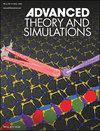Electroosmotic Effects on Peristaltic Transport of Ree‐Eyring Nanofluid with Double Diffusive Convection in Symmetric Microchannel
IF 2.9
4区 工程技术
Q1 MULTIDISCIPLINARY SCIENCES
引用次数: 0
Abstract
This study examines significant applications across various domains, including microfluidics, biomedical engineering, and energy systems, focusing on the advancement of lab‐on‐a‐chip technologies, electrokinetic pumps, and micro‐scale filtration systems. A detailed investigation is conducted to explore the combined influence of peristaltic transport, double‐diffusive convection, electroosmosis, magnetohydrodynamics (MHD), Hall current, viscous dissipation, thermal radiation, and porous medium flow in the presence of a heat source. The Poisson–Boltzmann ionic distribution is approximated using the Debye–Hückel method. The lubrication approach is adopted to make the system simpler. To solve nonlinear partial differential equations in a more sophisticated manner and to improve the reliability of models in various scientific and technical domains, this work uses the homotopy perturbation technique (HPM). A thorough investigation is conducted into the effects of key parameters on the flow characteristics using graphical representations. The results of this investigation show that, in the presence of double‐diffusive convection, the Helmholtz–Smoluchowski velocity parameter can improve the velocity distribution of the Ree‐Eyring nanofluid. Notable variations in trapped boluses are noticed due to the influence of some influential parameters. Furthermore, the present outcomes are validated with previous discoveries under specific conditions.电渗透对对称微通道中双扩散对流稀土环纳米流体蠕动输运的影响
本研究考察了微流体、生物医学工程和能源系统等各个领域的重要应用,重点关注芯片上实验室技术、电动泵和微尺度过滤系统的进步。详细研究了在热源存在的情况下,蠕动输运、双扩散对流、电渗透、磁流体动力学(MHD)、霍尔电流、粘性耗散、热辐射和多孔介质流动的综合影响。泊松-玻尔兹曼离子分布用debye - h ckel方法进行了近似。采用润滑方式,使系统更加简单。为了以更复杂的方式求解非线性偏微分方程,并提高各种科学和技术领域模型的可靠性,本工作使用了同伦摄动技术(HPM)。对关键参数对流动特性的影响进行了深入的研究,并采用图形表示。研究结果表明,在双扩散对流存在的情况下,Helmholtz-Smoluchowski速度参数可以改善Ree - Eyring纳米流体的速度分布。由于一些有影响的参数的影响,捕获量发生了显著的变化。此外,在特定条件下,目前的结果与先前的发现进行了验证。
本文章由计算机程序翻译,如有差异,请以英文原文为准。
求助全文
约1分钟内获得全文
求助全文
来源期刊

Advanced Theory and Simulations
Multidisciplinary-Multidisciplinary
CiteScore
5.50
自引率
3.00%
发文量
221
期刊介绍:
Advanced Theory and Simulations is an interdisciplinary, international, English-language journal that publishes high-quality scientific results focusing on the development and application of theoretical methods, modeling and simulation approaches in all natural science and medicine areas, including:
materials, chemistry, condensed matter physics
engineering, energy
life science, biology, medicine
atmospheric/environmental science, climate science
planetary science, astronomy, cosmology
method development, numerical methods, statistics
 求助内容:
求助内容: 应助结果提醒方式:
应助结果提醒方式:


